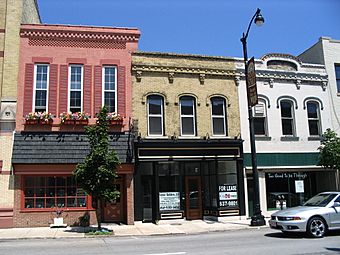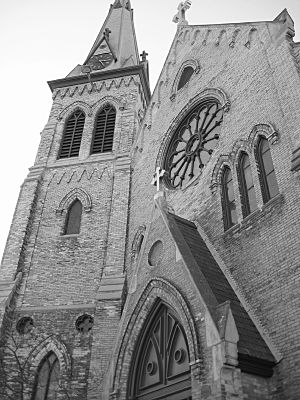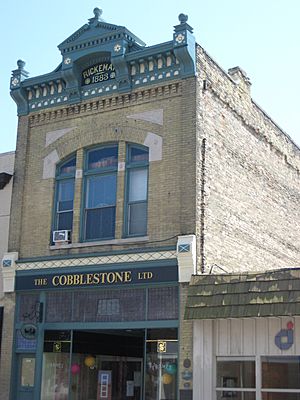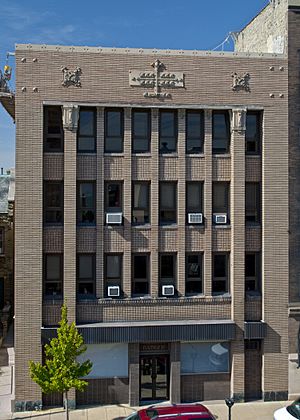Historic Sixth Street Business District facts for kids
Quick facts for kids |
|
|
Historic Sixth Street Business District
|
|

A portion of the district.
|
|
| Location | Racine, Wisconsin |
|---|---|
| NRHP reference No. | 88000263 |
| Added to NRHP | March 24, 1988 |
The Historic Sixth Street Business District is a collection of old shops and buildings in Racine, Wisconsin. Most of these buildings are two or three stories tall. They were built between the 1850s and the 1950s. This special area was added to the National Register of Historic Places in 1988. This means it's an important historical place!
Contents
Discovering Racine's Old Main Street
Racine started as a small settlement in 1834. A man named Gilbert Knapp claimed land along the Root River. He planned out the village in 1836. At first, most buildings were near the river. The area that became Sixth Street was just woods back then.
How Sixth Street Became Important
In 1838, a military road was built from Racine to Janesville. This road went right through the Sixth and Seventh Street areas. This made the area a key route for people traveling in and out of Racine from the west.
Early businesses were mostly on Main Street. But in 1848, a special road called the Racine and Rock River Plank Road was built. It started at Monument Square and went west along Sixth Street. This caused businesses to move and grow along Sixth Street, making it a busy area.
Famous Buildings and Their Styles
Let's look at some of the important buildings in the district. They show how styles and uses changed over the years.
Early Buildings: 1860s to 1870s
- The Ernst Hueffner Building at 409 Sixth St was built in 1861. It's a two-story shop made of cream-colored brick. The owner lived upstairs. It has an Italianate style, with cool round-arched windows on the second floor.
- The Stephen Campbell Building at 407 Sixth St is also Italianate. It has fancy brickwork. Its windows have arches made of three layers of brick.
- Osborn and Osgood's Block at 205-207 Sixth St was built in 1863. This three-story building is in the Italian Renaissance revival style. Its upper windows have round arches and columns.
- St. Luke's Episcopal Church, Chapel, Guildhall, and Rectory at 624 Main St is an Episcopal church. It was built in 1866 and 1867 in the Gothic Revival style.
- The Jacob and Charlotte Schad Building at 308 Sixth St was built in 1873. It's an Italianate building with brick window frames. It started as a saloon, with the owner living above. The similar August Garnkaufer tailor shop next door (310 Sixth St) was built in 1874.
- The Fire Museum at 700 Sixth St was built in 1881. It was Racine Fire Department Engine House No. 3. It's an Italianate building with a tall tower. The fire company was made mostly of Welsh immigrants.
- The First Augustine Furniture Company Building at 221 Sixth St was a three-story furniture store. It was designed by David R. Jones and built in 1881.
Buildings from the Late 1800s
- The Rickeman Grocery Building at 415 Sixth St is a two-story Italianate building. It has cream brick and limestone. George Rickeman, who fought in the Civil War, ran a grocery and saloon here. The front of the building has been restored to look like it did around 1910.
- The Gertrude Fleisher Building at 613 Sixth St was built in 1884. It was a two-story dry goods store. Its style is Italianate, similar to the Rickeman Grocery.
- The YMCA Building at 314-320 Sixth St is a three-story building. It was designed by James Gilbert Chandler and built in 1886. It's in the Queen Anne style, with cool bay windows and a corner tower.
- The Church of the Good Shepherd at 625 College Ave. was built in 1895. It's a Romanesque Revival-style building. This church was founded in 1842. Famous members included Gilbert Knapp and J.I. Case. P.T. Barnum even helped them buy land for their first church! Olympia Brown, the first woman ordained as a minister in the U.S., worked here.
Early 1900s Architecture
- The Robinson Building at 201-203 Sixth St is a five-story office building from around 1900. It has a mix of styles. Some windows are grouped in a "Chicago-style." Others have Neoclassical columns and fancy decorations.
- The Frank Lintner Building at 613 Wisconsin Ave is a unique three-story building. It has two huge bay windows and a metal roof edge. It's made of sand brick, which was a new type of brick at the time.
- The Ernest Johnson Building at 209 Sixth St was built in 1911. It's a three-story brick building with a shiny white terra cotta front.
- The Constance Dombrowski Building at 516 College Ave is a three-story building. It has stucco on the upper floors and a decorative metal roof edge.
- The First Ernst Klinkert Building at 615 Sixth St was built in 1915. It was a two-story tavern and pool hall. It has a mix of Neoclassical and Prairie Style influences. Klinkert was a big name in Racine's brewing history.
- The Badger Building at 610 Main St is a four-story office building. It was designed in the Prairie Style and built in 1915.
- The Robert E. Miller Building at 219 Sixth St is another Prairie Style building from 1915. It housed Miller's floral company. Over 100 years later, Miller's Flowers is still run by the same family in the same building!
- The American National Bank Building at 302-304 Sixth St was built in 1918. It's a three-story building with red brick, limestone, and three round decorations called rosettes.
- The George Kamm Building at 522 College Ave was built in 1926. It was a three-story showroom for cars, in the Commercial style.
- The Century Motor Company Building at 512-522 Sixth St was built in 1927. It was a showroom for Studebaker cars. It has horizontal lines and bright colors, showing Prairie Style and Art Deco influences.
- The Fred J. Hermes Building at 614-616 Sixth St was built in 1927. It's a three-story building that looks like Spanish Colonial Revival style. It has brown brick and limestone. The top has carved shields and twisted railings.
- Kaiser's at 218 Sixth St is a two-story store. Its front was redone in 1928 in pink terra cotta, in an Art Deco style. It was a men's clothing store for 40 years and still looks much the same.
- The First National Bank Trust Department at 216 Sixth St is next to Kaiser's. It's also Art Deco, but made of gray granite and built in 1933.
- The Fred W. Plath Building at 405 Sixth St is a one-story store built in 1930. It has big display windows and green marble and white terra cotta on the outside.




